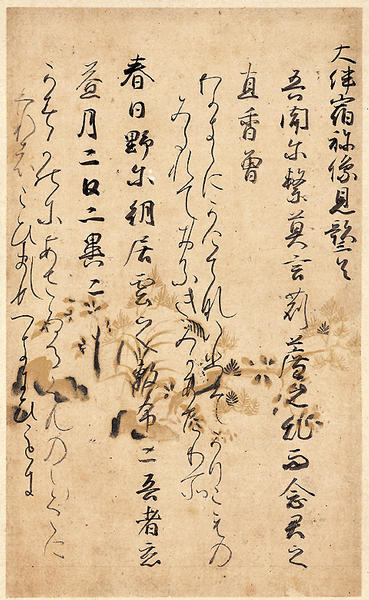Fragment of Scroll 4 of the Katsura Version of the Man'yoshu (Toganoo-gire)
- Late Heian period
- 11c
- Hanging scroll, ink on decorated paper
- H-21 W-12.6
- The Emperor Fushimi to Hoshun'in to Prince Katsura
Catalogue Entry
Fragment of Scroll 4 (known as Toga-no-o-gire)
Late Heian period, 11th century
Hanging scroll, ink on decorated paper
Height, 21.0cm; width, 12.6cm
The name for this version of the Man'yoshu derives from the fact that this version was traditionally held by the Prince of Katsuranomiya. Originally this version was mounted as a kansubon scroll. The remainder of this 4th scroll is now in the collections of the Agency for Cultural Affairs and reveals that a variety of papers were used for the scroll, including white, yellow, brown, and red, and that the underdrawings include images of trees, flowers and plants, and butterflies. The kao (written seal) of Emperor Fushimi appears on the seam on the back of the paper, and this indicates that it was a beloved possession of that emperor.
This scroll was also later in the collection of Matsuko (Hoshun'in), the wife of Maeda Toshiie of Kaga, and when her grandchild Tomiko became the bride of the Imperial Prince Toshihito, this work was transferred to the Katsu-ranomiya family. This version numbers among the Five Great Versions of the Man'yoshu, along with the Genryaku Kohon, Aigami, Kanazawa, and Tenji versions. The origins of the Toga-no-o-gire name are not known.
The titles of the poems are written slightly above the rest of the text, and the poems are written out in both full Chinese characters and in kana forms. The elegant flowing script has been traditionally ascribed to such famous calligraphers as Ki-no-Tsurayuki, Minamoto-no-Shitago, and the Imperial Prince Munetaka. Among extant texts, the same hand has been found in the Koyagire (second type), Sekido version of the Wakanroeishugire, and this resemblance supports the argument that the present fragment was written by Minamoto-no-Kaneyuki (dates unknown). MS
